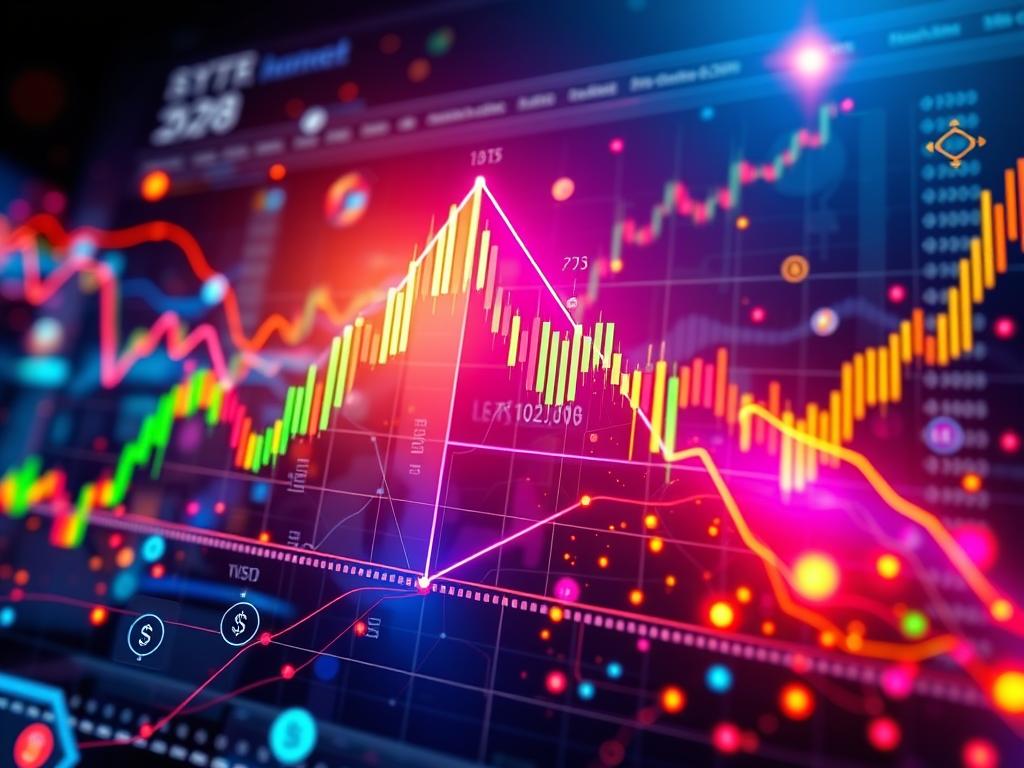Did you know that high-frequency algorithmic trading allows traders to grasp profits from minuscule price changes, yet it necessitates a robust technological backbone to be efficient? This precise mechanism captures the significance of using cutting-edge trading algorithms in today’s fast-paced financial world. At the intersection of superior technology and sophisticated mathematical models lies the potential to significantly maximize returns while aiming to minimize risks. As the financial markets become increasingly competitive, incorporating these advanced tools unlocks a multitude of financial opportunities for traders of all calibers.
Incorporating trading platforms like MetaTrader 4 and NinjaTrader into one’s investment strategy has redefined the essence of modern trading. Surmount’s no-code platform exemplifies the innovation in this sector, offering traders a simplified entry into the world of algorithmic trading. By leveraging algorithms that can analyze market data and execute trades within milliseconds, investors gain the advantage of consistency and speed—critical factors in today’s market landscape where even the slightest delay can mean the difference between profit and loss.
Key Takeaways
- Trading algorithms offer rapid execution of trades, enhancing the ability to tap into swift market movements.
- In forex trading, the precision and speed of AI enhance profitability and efficiency, handling larger trade volumes effortlessly.
- Algorithmic trading promotes liquidity in the market, although with potential volatility during unstable conditions.
- The emotional element of trading is removed, allowing strategies to operate logically and consistently in volatile markets.
- Backtesting with historical data is crucial for evaluating the performance of trading strategies before live execution.
- Diversification of risk through running multiple strategies can concurrently increase the probability of profiting.
Understanding the Power of Cutting-Edge Trading Algorithms
The financial trading landscape has evolved dramatically with the integration of advanced computer programs and quantitative trading methodologies. At the heart of this transformation are algorithmic trading strategies, which utilize sophisticated mathematical models to execute trades at high speeds and with high accuracy. This evolution marks a significant shift from traditional trading methods, where decisions were largely influenced by human intuition and emotion.
The Role of Mathematics and Computer Science
At the core of algorithmic trading lies a solid foundation in mathematics and computer science. These disciplines provide the framework for developing complex algorithms capable of analyzing vast amounts of market data to identify profitable trading opportunities. Notable academic contributions, such as those from Álvaro Cartea and Sebastian Jaimungal, have been pivotal in advancing these trading strategies. The use of powerful computer programs enables these algorithms to execute trades based on predefined criteria, removing emotional bias and enhancing precision.
How Computer Algorithms Shape Trading Today
Today, over 80% of stock market trades in the US are executed by automated bots like KONG, which operates on the Quantumbots platform. These bots are equipped with advanced algorithms, including those specializing in Volume Weighted Average Price (VWAP) strategies and dark pool executions. Their ability to operate continuously and process large datasets instantaneously fundamentally changes the market dynamics, offering traders unmatched efficiency and a significant competitive edge.
The Rise of No-Code Algorithmic Trading Platforms
In an effort to make algorithmic trading strategies more accessible, platforms like TrendSpider and TradeStation have adopted no-code solutions that empower traders without deep programming knowledge. These platforms provide pre-made scanners, extensive backtesting capabilities, and easy-to-use strategy generation tools using proprietary programming languages like EasyLanguage. This democratization of technology allows a broader range of investors to leverage the sophisticated tools that were once the exclusive domain of hedge funds and institutional investors.
Advantages of Quantitative Trading Techniques
Quantitative trading utilizes rigorous mathematical models to optimize trading strategies, making it a cornerstone of modern financial markets. These techniques, spearheaded by significant advances in computational technology, offer unprecedented speed and accuracy, fundamentally changing how markets operate.
Speed and Efficiency in Execution
One of the pivotal benefits of quantitative trading is its ability to execute orders at lightning speed. These methods leverage the latest computational tools to analyze and act on market data faster than any human could, often completing transactions in milliseconds. This rapid execution capability maximizes opportunities in fluctuating markets by capitalizing on temporary inefficiencies before they can disappear. Effective portfolio optimization algorithms, integral to these systems, help in fine-tuning investment portfolios to achieve optimum performance.
Objective Decision-Making Processes
Quantitative trading also introduces an objective framework for decision-making, stripping away the emotional biases that typically hinder consistent investment performance. Using backtesting trading algorithms, traders can simulate strategies on historical data, refining them without exposing capital to risks in real-time trading environments. This process not only builds confidence in the strategies but also improves their robustness, accounting for various market scenarios and conditions.
Moreover, the application of quantitative methods extends beyond mere execution. It encompasses comprehensive trading signal analysis, with traders employing sophisticated mathematical formulas and high-frequency trading frameworks to predict and react to market movements more efficiently.
In essence, the fusion of advanced analytics and automated solutions in quantitative trading not only enhances operational efficiency but also guarantees a higher standard of accuracy and speed. This scientific approach to trading ensures maximum profitability by harnessing the potential of state-of-the-art technologies and objective, data-driven strategies.
Exploring Different Algorithmic Trading Strategies
The landscape of financial markets has been profoundly reshaped by the advent of advanced high-frequency trading algorithms, automated trading bots, and sophisticated execution algorithms. These technologies not only accelerate the pace of trading but also enhance the accuracy and potential profitability of strategic operations. Here, we delve into three primary strategies that leverage these innovations to outperform traditional methods.
The Trend-Following Strategy
This strategy, heavily reliant on automated trading bots, seeks to identify and capitalize on market trends. Employing indicators like moving averages and momentum oscillators, trend-following algorithms persistently monitor and react to directional movements of asset prices. Particularly effective in market environments with high volatility, this strategy facilitates sizable gains by aligning trades with prevailing trends.
Application of Mean Reversion in Trading
Contrasting with trend-following, the mean reversion strategy is based on the theory that prices and returns eventually revert back to their mean or average level. This approach uses statistical and computational tools to detect anomalies and price extremes where assets have deviated significantly from their historical averages. Execution algorithms quickly capitalize on these discrepancies by initiating trades aimed at profiting when the prices revert to the norm.
Unlocking Profits through Arbitrage
Arbitrage strategies are quintessential examples of how high-frequency trading algorithms can be exploited for gains. These strategies involve simultaneous buying and selling of related financial instruments across different markets or forms to take advantage of price differentials. The velocity and computational power of HFT systems make it possible to detect and act upon these opportunities in a fraction of a second, which is crucial in maintaining a competitive edge in tightly contested markets.
Enhancing Your Trading Approach with Machine Learning Trading Systems
As the prevalence of machine learning trading systems continues to rise, the finance sector witnesses a significant shift in how trading decisions are made. These advanced systems capitalize on the ability to process large volumes of data, offering traders unprecedented speed and accuracy in their operations.

One key benefit of integrating machine learning into trading is the elimination of emotional bias, thus enabling a more disciplined approach to trading. The predictive power of these systems, which includes techniques from regression models and deep learning, helps in forecasting market behaviors with remarkable precision. With over 100 trading strategies available, the power to backtest using machine learning algorithms is invaluable, providing insights that were previously unattainable.
Moreover, the advent of algorithmic trading strategies has paved the way for implementing high-frequency trading (HFT) that can respond instantaneously to market fluctuations. By leveraging patterns recognized through machine learning models, these automated strategies ensure that trades are executed at the best possible prices, enhancing profitability.
Explore how to develop these strategies further by delving into predictive modeling techniques and their real-world application in creating powerful trading algorithms.
| Feature | Benefit |
|---|---|
| Predictive Modeling | Forecasts market trends using historical data |
| Real-time Data Processing | Enables quicker and more accurate trading decisions |
| Emotion-free Trading | Increases discipline in trading with strategic decisions |
| Machine Learning in HFT | Capitalizes on market fluctuations swiftly |
| Risk Management Optimization | Enhances portfolio performance by balancing risk and return |
As machine learning continues to evolve, its impact on trading grows exponentially, providing traders with a robust toolset for maximizing their investment strategies and outcomes. The integration of machine learning trading systems and algorithmic trading strategies not only sharpens competitive edges but also reshapes the landscape of trading as we know it.
How High-Frequency Trading Algorithms Are Changing the Game
The realm of financial trading has been radically transformed by the advent of high-frequency trading algorithms, known for their ability to execute orders within microseconds. The implementation of these sophisticated algorithms exemplifies significant strides in algorithm complexity and high technical ability, pivotal in staying ahead in the fast-paced trading environment.
Understanding High-Frequency Trading (HFT)
High-frequency trading (HFT) encompasses a variety of strategies that capitalize on executing large volumes of orders at extremely fast speeds. These algorithms are designed to make split-second decisions, capturing minute price discrepancies that can translate into substantial profits over time. By capitalizing on fleeting arbitrage opportunities, these algorithms ensure markets operate more efficiently by correcting price discrepancies promptly.
Infrastructural Needs for HFT
Implementing high-frequency trading algorithms requires an infrastructure that can handle vast amounts of data and execute trades in milliseconds or less. This demands robust technological frameworks and extensive computational resources, highlighting the necessity for continuity in innovation and maintenance within HFT infrastructures. Major trading hubs like New York, London, and Tokyo, among others, continuously evolve their tech capabilities to meet these needs, involving elite HFT firms like Citadel Securities, Virtu Financial, and Jump Trading, which dominate the scene by virtue of their high technical ability and advanced infrastructural facilities.
Automated Trading Bots: Setting Up For Success
As the financial industry continues to evolve, automated trading bots are becoming a staple for investors looking to maximize efficiency and profitability. These bots are engineered to exploit market inefficiencies and operate around the clock, enhancing the trading strategies through advanced artificial intelligence (AI) and machine learning capabilities.

Deploying these advanced bots effectively requires a solid understanding of both the technology and the specific needs of your trading strategy. Particularly in the volatile realm of cryptocurrency trading, where AI trading bots have revolutionized operations by minimizing emotional human biases and improving decision-making processes.
Designing Effective Automated Strategies
Effective strategy design is essential for harnessing the full potential of automated trading bots. An increase in the integration of AI technologies points towards a clear trend: automation not only handles repetitive tasks but also learns and adapts to new market inefficiencies continually. Platforms like MetaTrader 4 and Alpaca provide robust environments where traders can set up and backtest their bots to ensure optimal performance.
Risk Management in Autotrading
Risk profiles vary significantly among traders, and automated bots must be tailored to respect these variances. Tools like RSI and moving averages are essential in crafting a bot’s decision framework that aligns with user-defined risk parameters. Monitoring and continuously tuning your bot, considering unexpected market inefficiencies and potential technical glitches, form an integral part of effective risk management in autotrading. Moreover, platforms such as AlgoTrading101 provide educational resources that aid traders in understanding the nuances of setting risk management protocols for their bots.
Overall, the strategic integration of automated trading bots can lead to significant advantages in terms of operational efficiency, speed, and the ability to capitalize on market movements that might be too subtle for human traders to exploit. However, success relies on meticulous setup, ongoing adjustments, and a deep understanding of both the technology and the market inefficiencies it is designed to address.
Backtesting Trading Algorithms: Ensuring Performance
For cryptocurrency traders seeking profitability and sustainability, backtesting trading algorithms is an indispensable practice. By leveraging historical data, traders can simulate how their strategies would have fared under various market conditions, thereby gaining insights into potential future performance.
The Importance of Historical Data
Historical data plays a pivotal role in backtesting trading algorithms. It provides the raw material for testing and refining trading strategies against the actual movements of the market. The quality and granularity of this data—be it hourly, daily, or tick data—directly influence the reliability of the backtesting results. When historical data is comprehensive and detailed, traders can better identify nuanced trends and patterns that could dictate the success or failure of their strategies.
Identifying and Adjusting to Market Anomalies
One critical aspect that backtesting trading algorithms reveals is the presence of market anomalies. These can range from irregular price spikes due to geopolitical events to unusual trading volumes. By identifying these through backtesting, traders can modify their algorithms to either capitalize on these anomalies or to adjust their strategies to mitigate risks associated with them. This fine-tuning is an integral part of developing robust risk management techniques that aim to protect investments while seeking optimal returns.
To integrate enduring trading principles with modern technology effectively, traders can look to historical figures like Jesse Livermore, whose philosophy in trading emphasized patience, discipline, and stringent risk management techniques. By applying Livermore’s methods to contemporary algorithmic trading, particularly in trend-following and risk measurement, traders can enhance the sophistication and effectiveness of their own strategies.
Moreover, incorporating Livermore’s approach helps in addressing common pitfalls in backtesting such as look-ahead bias, data-snooping, survivorship bias, and overfitting. Each of these can skew results and lead to misguided strategy decisions if not properly managed.
Overall, backtesting trading algorithms serves not only to validate a trading strategy but also helps in sculpting powerful risk management techniques that are essential in today’s volatile trading environments. For more insights into extending the capabilities of backtesting, explore comprehensive resources available here that discuss various aspects of digital asset investments and market strategies.
Unlocking Advanced Trading Potential through Portfolio Optimization Algorithms
In the age of automation and artificial intelligence, portfolio optimization algorithms stand at the forefront of revolutionizing financial markets. These sophisticated tools are designed to enhance investment strategies by incorporating risk management into the process of asset allocation. They offer the ability to transform mounds of data into actionable insights, enabling traders to sculpt portfolios that efficiently balance risk against potential returns.
Constructing a Risk-adjusted Portfolio
By employing machine learning and advanced analytical techniques, portfolio optimization algorithms are capable of dissecting complex datasets to discern intricate patterns and make predictive assertions. These algorithms adeptly quantify risk, forecast returns, and facilitate the creation of risk-adjusted portfolios. Particularly in a landscape where high-frequency trading (HFT) and real-time data analysis are ubiquitous, the algorithms’ dynamic adaptability and self-improvement mechanisms are invaluable. With over 100 exchanges integrating tools like the Barbotine Arbitrage Bot, the necessity for such optimized strategies becomes even more pronounced.
Maximizing Returns with Optimized Allocations
Optimized allocation isn’t just about maximizing returns; it’s about smartly navigating the volatility inherent in financial markets. Analytics like the Vertical Horizon Filter (VHF) and predictive measures from AI-driven systems like Stock Trading AI inform traders of trend strengths and market movements. These insights not only catalyze the decision-making process but also refine risk management strategies, offering traders a potent tool for capitalizing on market efficiencies. As AI continues to minimize human error and enable emotion-free investment choices, the promise of enhanced long-term profitability becomes increasingly accessible to traders equipped with these advanced algorithms.
